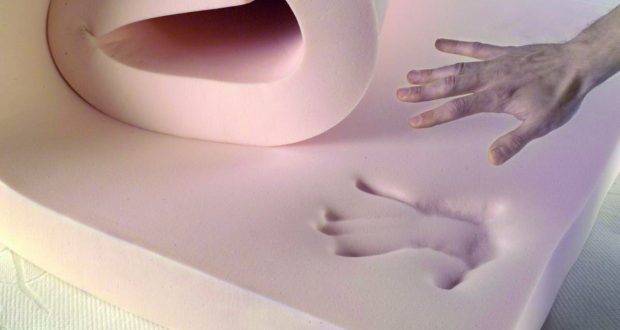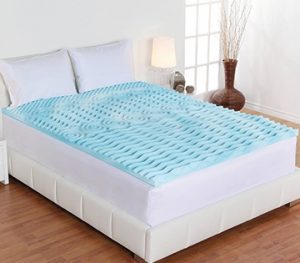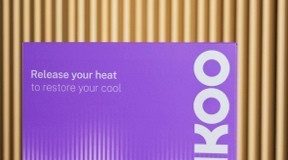By Jessica Jones at thesleepjudge.com by Frank Apodaca
A restful night’s sleep offers more to our overall health and well being than we often give it credit for. According to Harvard University, just some of the consequences of not getting enough sleep include:
- Obesity
- Hypertension
- Diabetes
- Mood disorders
- Heart disease
- Shortened life expectancy
One of the best ways to ensure that you get the sleep you need on a consistent basis is to find the mattress that works for you. If you’re considering a foam mattress, you need to understand that “foam” is a broad category with a variety of specifications. Let’s delve into the many different types of foam to ensure you make the most informed decisions.
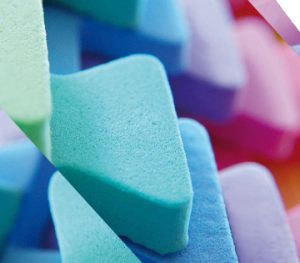 1- POLYURETHANE FOAMS
1- POLYURETHANE FOAMS
If you don’t think you’re familiar with polyurethane foams, then you may have been introduced under a different name such as polyfoam or just poly. When it comes to mattress comfort layers, this type is the most common, and it’s very likely you have experienced its use whether sleeping over at a friend’s house, in a hotel, or even in your own home.
Just what is it?
Polyfoam is quite similar to memory foam structurally. The primary difference is that memory foam uses additional chemicals in the manufacturing process that allows it to seemingly “melt” when you lay down on it. As you shop, keep in mind that there are three grades of polymer foam, and this determines the softness or firmness of the product. Therefore, avoid the propensity to judge quality on firmness as polyfoam is versatile in this area. Instead use density as a means to judge the quality of the PU foam.
Easy on the budget, but at what expense?
If the budget is of primary importance in your shopping endeavor, then polyfoam may be the right option for you. However, before you happily start browsing these often inexpensive options, keep one thing in mind. You get what you pay for, and the lower price of polyurethane often translates to a decrease in quality. Even if you’re shopping in the store, it’s important to remember that, since this type of foam can be manufactured in a way that makes the mattress very soft, polyfoam lacks in durability, so this initial comfort is all too often short-lived. Some common complaints many consumers have made include:
- Development of body impressions over time
- Excessive offgassing
- Lack of support
A few pros worth mentioning
We all have different goals when shopping for a new mattress. For instance, perhaps you’re on a budget and need a new mattress for your child but plan to replace it after a few years as they grow older. In circumstances where price trumps durability, this could be the best choice for your needs. You can also take advantage of a few other benefits like:
- Effectively blocks dust mites and other allergens
- Acts as a barrier to liquids for those unexpected spills
- Helps encourage proper spinal alignment
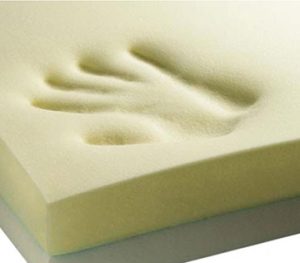 2- MEMORY FOAMS
2- MEMORY FOAMS
Memory foam is a close relative to polyfoam in that it uses the same materials and processes in manufacturing. However, as mentioned in the last section, it adds the use of chemicals that increases both its density and viscosity. Because of this fact, it’s also known as viscoelastic polyurethane foam. The term “memory foam” derives from the fact that, when you lay on it, it quickly conforms to your body and retains the impression.
If this idea intrigues you, then something you want to stay mindful of is the density of particular products you may be considering. Remember that, the higher this number, the better the product’s ability to soften in response to your body heat and the better durability the mattress will have.
Three primary types of memory foam
As you shop, it’s important that you understand that there are three primary types of memory foam. Understanding their differences will help you find the product best suited for you.
1. Traditional Memory Foam
- Entered the market in the mid-1990’s
- Designed for cradling support to enhance circulation and decrease stress on your joints
- Can cause discomfort due to excessive heat retention
2. Open Cell Memory Foam
- Designed to cater to consumers complaining of excessive heat retention in traditional memory foam
- Responds to body temperature to help ensure you don’t get too hot
- Faster Response
3. Gel Memory Foam (We’ll discuss in detail in a moment)
- Reduces pressure points and motion transfer while offering the support you need
If you suffer from chronic back and/or neck pain, memory foam may be the best choice for you as long-term use has been shown to reduce the overall discomfort caused by these conditions. Allergy suffers can also benefit from its hypoallergenic properties. As you shop, it’s worth taking a look at a listing of the best memory foam mattresses on the market.
3- GEL FOAM
We touched briefly on gel foam when discussing memory foam, and this is because it is typically infused into the latter. Just like air cool memory foam, this is done in order to better promote heat transfer to help you sleep cool. Therefore, if you are excited by the prospects of memory foam but don’t want to compromise your body temperature during sleep, this is an option well-worth looking into further.
How heat transfer is promoted
To understand just how clever scientists developed this product to disperse heat, you have to take a quick look at how it’s made. Without making it too difficult to wrap your mind around, let’s just say it’s made using tiny gel beads. These beads act to create an open-cell structure which helps encourage proper air flow.
While we often think of being warm and cozy in bed, our body temperatures actually decrease as we drift off to sleep, and sleep isn’t achieved until this temperature is reached. Therefore, if you’ve found yourself tossing and turning at night, it very well may just mean that you need a mattress that offers better heat transfer.
Close relative of memory foam
Feedback and constructive criticism, when taken to heart, can help us improve, and this certainly holds true when it comes to the development of gel foam mattresses. Essentially, they are very much the same as traditional memory foam mattresses. However, they implement this additional technology as thoughtful manufacturers listened to real consumer feedback. The end result is a product that offers the same benefits of memory foam with the added comfort of a cooler night’s rest.
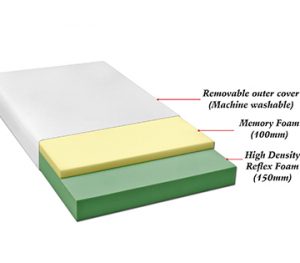 4- REFLEX FOAMS
4- REFLEX FOAMS
Money can be tight, and, while you may be impressed with products containing memory foam technology, not all of us can afford it. If you want to take advantage of a cheaper alternative, it’s worth taking a look at reflex foam. This high-density polyurethane foam is noted for its medium level of firmness, and, like memory foam, it’s produced using polyurethane. However, where memory foam uses holes, reflex foam uses bubbles that work to move to conform with your body. However, when pressure is released, the bubbles bounce back to their original form, hence the name “reflex foam.”
Aiding in proper spinal alignment
It’s estimated by the Arthritis Disease Center that between 50 and 80 percent of Americans suffer from back pain at some point in life, and poor posture and spinal alignment is a primary contributing factor. Considering the fact that you likely spend just as much time sleeping as you do at your job, it’s clear that having your spine aligned is highly important. When you rely on reflex foam, you can rest assured that the material is beneficial in fostering proper back and spinal health. Just a few other helpful features you should be aware of include:
- Resistant to dust mites, a great feature for those suffering with asthma
- Often firmer than memory foam, a benefit for those who dislike the “sinking in” feeling of memory foam
- Has the “bounce back” quality despite the higher degree of firmness over memory foam alternatives
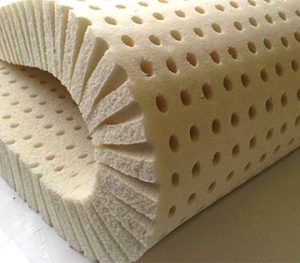 5- LATEX RUBBER FOAMS
5- LATEX RUBBER FOAMS
For a growing number of us, considering the environment is an important factor to consider before buying any product. With growing concerns regarding issues like global warming, taking the needs of future generations is important, and you can rest assured that latex rubber foams helps you reduce your carbon footprint. This is because it’s created using a milky-white sap found in trees, making it an all-natural product made from renewable resources.
A look behind the manufacturing process
Once the liquid rubber is extracted, it is then whipped up to make a foam that is placed in a mold. The mold contains rods that penetrate the latex and are heated. This acts to reduce air pockets and makes the firmness of the mattress more even.
While this process is standard, when you add a couple of extra steps, you move into the Talalay latex manufacturing process. Once the latex is placed into its mold, a vacuum acts to remove air bubbles to further promote even heat distribution. It is then instantly frozen in order to ensure the lock in this consistency.
Subtle Differences to Note
It’s clear to see that a little extra work goes into the development of Talalay latex, and you obviously want to know just how the differences will impact your sleep. While you may notice that many manufacturers will make these differences seem highly dramatic, they are actually quite subtle.
Our goal is not to sell you a particular product. Rather, we want to help lead you to the product best suited for you. That’s why we want to highlight the primary differences so you are aware. These include:
- Talalay latex is bouncier while alternatives are more springy
- Talalay is less dense
- Talalay is often less energy-efficient since there are additional steps in the manufacturing process
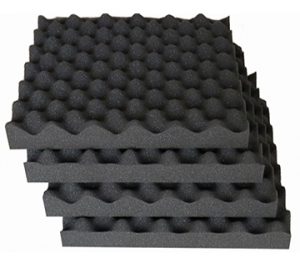 6- CONVOLUTED FOAMS
6- CONVOLUTED FOAMS
Convoluted foam is more commonly known as “egg crate foam.” The reason behind the naming is simple as the product resembles an egg crate with its peaks and valleys. It can be commonly found in mattress toppers as they do offer sleepers an added level of support during their nocturnal slumber.
When seeking out convoluted foams, you won’t be disappointed at availability. Because of the simplicity of the manufacturing process, you can purchase egg crate foam at a very low price. A few other benefits to be taken advantage of include:
- Fosters a high degree of heat dispersion as well as weight distribution
- Beneficial in spinal alignment and relief from pressure
- Simple to get set up as well as pack up if you need to move your bed
- Can help in the alleviation and healing of painful bedsores
An overview of the setbacks
While there are a few obvious reasons why convoluted foam could be the best choice, there are two sides to every coin.
- They feature an irregular surface, and this can make them difficult to clean. Although you should be using sheets and a mattress protector.
- Products that are not made of medical-grade urethane can cause adverse reactions in allergy sufferers.
- They often lack sufficient support and typically need a firm mattress beneath to act as a supplement.
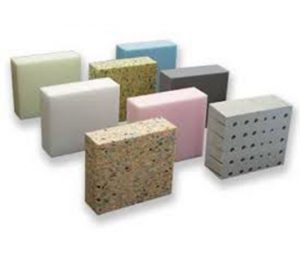 7- EVLON
7- EVLON
Another foam on the market that’s easy on the budget is Evlon foam. Commonly used as a high-end sofa foam, it features a high degree of quality considering the cost. Just a few stats to help you get a better understanding of what to expect include:
- Weight of 2.2 lb. per cubic ft..
- Average tensile strength of 17.19 lb. per cubic ft.
- 207 percent elongation
- Indentation force deflection of 41-47
 Safety and VOC
Safety and VOC
It’s clear there are many materials on the market from which to choose. While density and durability are important, I’d like to take a moment to discuss an aspect of purchasing a new mattress that you don’t typically think about until you unbox.
Because there are various chemicals involved in the manufacturing process, some become unstable shortly after the manufacturing process is completed and the product is exposed to room temperature. This results in the degradation of volatile organic compounds, better known as VOC’s. This is relevant to density as higher-density foams contain greater numbers of polymers. Therefore, they can sometimes have stronger initial odors.
This response is something you’ve experienced if you’ve ever purchased a new car, furniture, clothes, and many other items. It’s not permanent, but it can be irritating for some. The prevalence of the release of VOC’s differ according to the product you choose. While only a minute percentage of consumers return mattresses as a result of offgassing, there are some who may experience allergic-like reactions.
Is there cause for safety concerns?
Overall, there is little cause for concern about considerable safety issues associated with the purchase of a new mattress. According a study performed by the Agency for Toxic Substances and Disease Registry, there is no scientific connection between offgassing and respiratory problems. However, if you already know that the release of VOC’s is something that is bothersome to you, a few things to consider as you shop include:
- Look for plant-based foams
- Look for certification from Certipur and Oeko-tex
- Lower-density typically features less offgassing, but you may compromise on quality
I personally don’t suggest compromising on quality simply due to a temporary side-effect of the manufacturing of foam products. Therefore, it would be my personal suggestion to simply allow your mattress to air out for a day or two before use if this is something that is particularly bothersome.
A few limitations to keep in mind
Before you decide that Evlon foam is right for you, it’s important to know that there are a few potential drawbacks that might make you reconsider. For starters, if you prefer anything other than firm mattresses, this isn’t the right option for you as they are only available in firm. Furthermore, the average lifespan is around five years, so if you’re looking for something that will last awhile, you may want to consider other options.
Material Qualities at a Glance
Scale 1-10 with 10 being optimal
| Material | Cost | Heat Retention | Durability | Motion Xfer | Popularity |
| Polyurethane | 8 | 5 | 3 | 8 | 8 |
| Convoluted Foam | 9 | 9 | 4 | 8 | 9 |
| Memory Foam | 6 | 3 | 7 | 9 | 9 |
| Gel Foam | 7 | 8 | 8 | 8 | 6 |
| Reflex Foam | 8 | 7 | 7 | 7 | 6 |
| Latex Rubber Foam | 6 | 7 | 9 | 7 | 6 |
#guncel
 SleepTech Magazine Mattress, Accessories, Machinery, Raw Materials
SleepTech Magazine Mattress, Accessories, Machinery, Raw Materials
